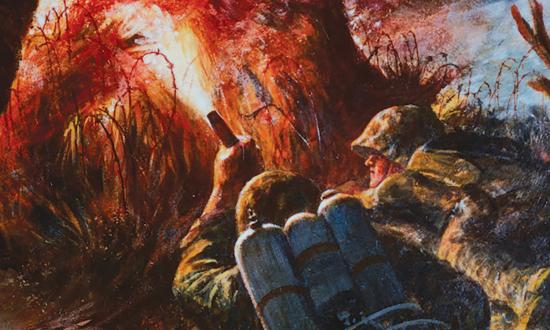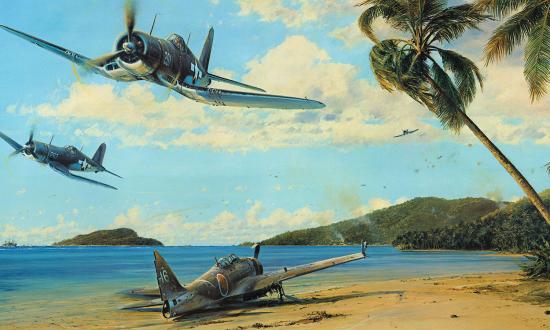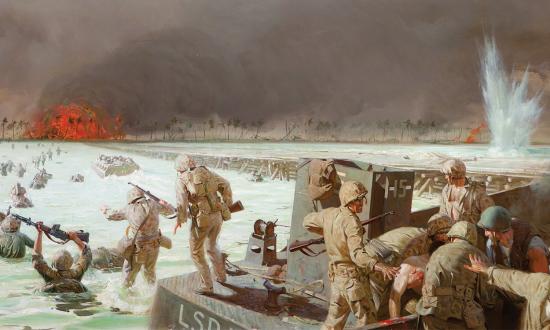The Battle of the Philippine Sea is one of the most important naval battles in American history. It is well-trod terrain for historians, and the story has been told countless times. On that fateful day in June 1944, Admiral Raymond Spruance defied conventional wisdom and put his fleet on the defensive, opting to stand guard on American landing forces rather than charging out to meet the approaching Japanese fleet head-on. When the enemy came to him, U.S. fighters devastated their planes in the air, while U.S. submarines sank two of their carriers. The Battle of the Philippine Sea broke the back of Japanese naval aviation in World War II; when enemy flattops made their next appearance at the Battle at Leyte Gulf, they were useful only as bait.
Despite decades of study, an important aspect of this battle remains largely unexamined: the contributions of the U.S. Navy’s Independence-class light aircraft carriers (CVLs). More than half of U.S. carrier decks that day were CVLs, and some of their fighters were among the first to meet the Japanese aerial attack. Despite this, most of the scholarship on the battle has focused on the role of their larger Essex-class sisters. So chronically overlooked are the light carriers that one of their veterans’ organizations dubbed them “the forgotten flattops.”
The CVLs have a remarkable story in their own right. They were a desperate stopgap measure, built to replace the Navy’s 1942 carrier losses until the larger Essex-class fleet carriers could be constructed in sufficient numbers. Based on the hull of a Cleveland-class light cruiser, the CVLs were imperfect flattops. They were short and stubby in comparison to the Essexes, two-thirds the length and capable of carrying only one-third the number of planes—33 in all. They were uncomfortable for their crews, unstable in high seas, and dangerous to fly from, with some of the highest accident rates in the fleet.
They had advantages, however: They were fast and long-ranged enough to keep up with the Navy’s carrier task force on its long forays across the Pacific. They also were relatively quick to build, using assets that were already in the Navy’s construction pipeline.
Despite their modest capabilities, these ships blazed a remarkable service record. Collectively, they earned 80 battle stars, helped 60 pilots become fighter aces, and carried future Presidents Gerald Ford (USS Monterey, CVL-26) and George H. W. Bush (USS San Jacinto, CVL-30) into battle.
Most importantly, they joined the war in the Pacific at the precise moment they were needed most, helping Admirals Raymond Spruance and Marc Mitscher deliver a decisive blow against the Japanese in the Philippine Sea. They were workhorses of the fleet and critical supporting players in winning the war. Afterward, they were discarded and forgotten—and virtually no trace of them remains.
The Cowpens and Air Group 25
While each of these nine ships had a proud service record, one in particular stands out: the USS Cowpens (CVL-25), known affectionately to her officers and men as “the Mighty Moo.” Putting to sea in 1943 with an untested crew, the Moo fought in every major carrier battle—with the exception of Okinawa—from 1943 until the end of the war without ever being hit by the enemy. For this she earned 12 battle stars, the most of the CVLs. At war’s end, she had the honor of being the only U.S. aircraft carrier in Tokyo Bay to witness the final Japanese surrender.
The Cowpens and her pilots from Air Group 25 joined the U.S. fast carrier task force in September 1943. Although still green when they first tasted combat at Wake Island, these pilots grew in experience and confidence in subsequent operations: the Gilbert and Marshall Islands, Truk, Palau, and Hollandia. By June 1944, squadron rotations left the Cowpens’ Air Group 25 one of the most experienced in Task Force 58. They were among the few remaining who had participated in the first carrier raid on the Mariana Islands in February 1944.
During Operation Forager, the invasion of the Marianas, the Cowpens was part of Task Group 58.4 under Rear Admiral William “Keen” Harrill. This was the smallest of the carrier groups in Task Force 58, including the Moo, her sister ship Langley (CVL-27), and the Essex (CV-9). The Moo got off to a bad start, with several pilots lost in the first two days over Saipan—one to enemy fighters, another to ground fire, and a third missing in action. The fourth was Air Group 25’s skipper, Lieutenant Commander Bob Price, shot down while attacking an enemy convoy. He was spotted alive and unhurt in the water, but two separate attempts to recover him failed to account for his drift on the currents. Even after the Cowpens’ commanding officer, Captain Herbert Taylor, pointed out the error to Admiral Harrill and his staff, they refused to authorize a third rescue mission. Price’s friends and colleagues on board the Moo mourned his loss, but he was miraculously recovered at sea 11 days later.
After a brief diversion to the Bonin Islands—where the Moo and another task group conducted a day of strikes—the Cowpens rejoined the task force off the Marianas on 18 June. U.S. submarines reported that the Japanese fleet had sortied to oppose the landings and was likely to arrive the following day. That evening, the Cowpens’ executive officer, Commander Hugh Nieman, informed Lieutenant Commander Gaylord “Brownie” Brown, the acting air group commander, that battle was imminent. The Moo had orders to keep eight F6F Hellcats in the air at all times and another 14 ready to launch at a moment’s notice.
General quarters sounded on board the Cowpens well before dawn, and her fighter pilots from Fighter Squadron 25 (VF-25) assembled in their ready room. Fighter pilot Lieutenant (junior grade) Don McKinley likened the mood to a locker room before a big football game: “[nervous] butterflies and little conversation.”1 When the Japanese did not soon appear on radar screens, some pilots on other carriers went to grab a meal or even a nap. But the Moo’s pilots stayed put, awaiting the order to fly. “We were ready to go,” McKinley recalled.2
‘Pilots, Man Your Planes’
Shortly before 1000, the leading wave of the enemy attack began to appear on U.S. radar screens. Those planes already in the air charged toward the enemy. Hellcats from the “Fighting 15” of the USS Lexington (CV-16) were in the lead, followed by eight fighters from the Cowpens and others from the Bunker Hill (CV-17), Princeton (CV-37), and Enterprise (CV-6). Below, all 15 American carriers swung into the wind and accelerated to 20 knots to begin launching aircraft. VF-25’s unwillingness to relax its guard paid off; the Cowpens distinguished herself by being the first to get her ready fighters into the air. Only two minutes passed between the order to launch planes and the first of the Moo’s Hellcats lifting off the deck.
VF-25 pilot Ensign Ed Haley recalled that it was a true scramble, with general quarters blaring at the same time as the direction for “pilots, man your planes.”3 The only instructions given were not to waste time joining up as a squadron or with designated wingmen. Instead, McKinley recalled, the Moo’s planes assembled in the air with whomever they could find, pointed their planes west toward the enemy, and “hung on their propellers” to gain altitude as fast as possible.4 In the air, McKinley formed up with one of his roommates, Lieutenant (junior grade) Fred “Stinky” Stieglitz, while Haley joined up with another Cowpens pilot, Lieutenant (junior grade) Lee Adams.
Brownie was already in the air; he’d volunteered for the first rotation of combat air patrol that morning. He was guided into the fight by one of the task group’s fighter direction officers, whose calm voice on the radio steered him to within five miles of enemy fighters and then directed him to “look sharp” when they should be in view. Seeing the dark specks of planes ahead, Brownie called out, “Tally ho!” and turned his division of four planes to attack. The enemy formation of perhaps 25 to 30 planes was scattering, Brownie recalled, with the bombers diving away and only the fighters remaining at his altitude.
As Brownie closed in, two Zekes turned to meet his approach. Brownie and his wingman, Lieutenant (junior grade) Relly “Raffles” Raffman, turned into the lead plane to attack. The Zeke broke off and made a climbing turn, so Brownie engaged his Hellcat’s water injection system for a burst of speed. He closed to within 200 yards, and firing from behind and below, sliced parts off the Zeke. As Brownie pulled away, Raffman moved in behind. His own burst of fire set the enemy plane ablaze, sending it arcing down to the sea.
With the formation of enemy planes scattering, Brownie and Raffman headed toward the task group. Through a break in the clouds they spotted a lone airplane circling. Brownie moved in to investigate, thinking that “if one of our planes had gotten separated from its leader, it would have headed for the carriers and would not be circling.”5 Drawing closer, he confirmed it was a bomb-carrying Zeke and maneuvered onto its tail. “I splashed him in flames with one burst,” he recalled.6
By this point, the Cowpens’ ready fighters had arrived on the scene. McKinley recalled how “the sky was full of planes at all altitudes, some burning and falling.”7 He and Stieglitz were climbing through 7,500 feet when he saw a trio of Jill torpedo planes flying in a tight V-formation a thousand or so feet below. With a wave and a point from his cockpit, McKinley signaled to Stieglitz that he would attack. The pair swooped down behind the torpedo bombers, who split up as the two Hellcats closed in. McKinley chased the pair that broke to the right and Stieglitz the lone Jill that turned to the left. Stieglitz caught up with his quarry and quickly flamed it. He called out “scratch one fish” on the radio, pulled away in a climbing turn, and was never seen again.8
Wild Wave-Top Dogfight
McKinley pursued the remaining two Jills into a high-speed dive toward the wave-tops. They weren’t taking evasive action, so he closed to within 100 yards or so before opening fire. After several gun bursts, the lead aircraft started smoking until it rolled over and careened into the water. McKinley followed it to make sure that it went in, and then sped after the second Jill, which was trying to make a break for it, skimming above the waves. Pulling in behind, McKinley was so focused on his target that he did not notice they were heading directly toward a friendly Essex-class carrier. The flattop’s antiaircraft guns were blazing away, trying to down the Jill before it dropped its torpedo. McKinley hit the plane with several bursts of fire; it lost control and hit the water with a tremendous splash.
Now seeing the friendly carrier a mile ahead—and the splashes from its gunfire hitting the water all around him—McKinley pulled away. The American gunners, seeing the profile of his Hellcat for the first time, immediately stopped firing.
Haley and Adams fell behind the rest of the Cowpens’ planes while climbing toward the melee. Arriving on the scene, they saw a dogfight at wave-top level and dived down to join the fray—which turned out to be five Hellcats trying to dispatch a single Zeke. The enemy pilot was particularly skilled, and used his plane’s maneuverability at low altitude to keep the Hellcats from getting into a good firing position. Haley described how “each time one of us would get on his tail . . . he managed to roll inside our turn.”9 The fight went on for what seemed to Haley a very long time, and after failing to connect with a few bursts of his own, his guns started overheating, so he pulled away.
Haley was circling above the fray when the Zeke somehow eluded the other U.S. fighters and fled to the west. Haley spotted him, and turned his faster Hellcat in pursuit. After a race of about 40 miles, he managed to close the distance and get on the enemy plane’s tail. He missed with his initial burst but anticipated his prey would try to roll to the left, as the Zeke was sluggish to the right at that speed. Sure enough, the enemy pilot broke to the left—straight into Haley’s gunsights.
With a blast from all six of his guns, Haley caught the Zeke in the wing root and cockpit. It rolled over and went straight into the sea. Suddenly aware that there was no one else in sight, Haley turned back for home. Years later, he vividly recalled his relief when the task force drew into view. “It was an awesome sight, the whole Fifth Fleet steaming west, stretching to the limit of my visibility from horizon to horizon.”10
Nearby, Ensigns L. J. Eckhardt and George Massenburg became separated from their division after a hectic dive to pursue enemy planes. Climbing back to altitude, they stumbled into an additional group of enemy fighters. Massenburg’s engine had been running poorly ever since he had taken off, but he still managed to get in a shot at a passing Zeke. Unfortunately, at just that moment his engine cut out completely and the enemy fighter pulled in behind him. Eckhardt shot the enemy fighter off his friend’s tail, drawing smoke—later judged to be a probable kill. Massenburg radioed that he was going to have to ditch, however, and so Eckhardt let the wounded Zeke go and followed his friend down.
Massenburg made a successful water landing and got into his survival raft. Eckhardt radioed his position to the fleet: only 50 miles west of the task force. He circled overhead until his fuel ran low and forced him to return to base. The request to recover Massenburg went up the chain of command from the Cowpens to Admiral Harrill and his staff on board the Essex, but either by omission or decision, no rescue was attempted, and Massenburg was never seen again.
A Bittersweet Victory
Thus ended the Cowpens’ contribution to the greatest carrier battle of the war, an experience that its pilots described as “something to write home about.”11 Her pilots claimed nine kills—five Zekes and four Jills—and three more probables. Back in the squadron ready room, VF-25’s satisfaction with the day’s victory was dampened by its two losses—and particularly Massenburg’s abandonment at sea. The pilots were furious at Harrill; they still blamed him for Price’s loss. The squadron history described how “the failure of our admiral to rescue Massenburg is another nail in the coffin as far as we are concerned. Morale was never lower than now as a result of the admiral’s indecisive policy regarding rescue.”12
Air Group 25 learned of Bob Price’s rescue on 25 June and was detached from the Cowpens at Pearl Harbor on 17 July for transport back to the United States. Both developments lifted the morale of an air group that was badly fatigued from a long stretch of combat duty. In a month of supporting Operation Forager, the Moo’s pilots flew 959 sorties—which the Navy publicized as an endurance record for carrier aviation, with each pilot spending at least four hours a day in the air for 23 days straight. During the busiest days some section and division leaders were spending as much as 12 hours a day in the air. But these trials were in the rearview mirror as the air group boarded a boat for home. “It is over!” cheered the squadron history. “We are on the way out, for keeps.”13
The Battle of the Philippine Sea was one of the decisive naval battles of the war, putting the prospect of victory forever out of Tokyo’s reach.14 Each of the eight CVLs present made her own important contribution to the end result, in terms of fighters in the air or enemy aircraft downed.
But the enemy was a long way from finished, and the 15 months between the battle and the final surrender in Tokyo Bay were the Cowpens’ most difficult. Two-thirds of the Moo’s total combat casualties were in the last year of the war, particularly in the vicious fighting off the Philippines in the fall of 1944. Moreover, the Moo would face the worst that mother nature could throw at her in Typhoon Cobra, when howling wind and pounding waves brought the ship to the edge of capsizing.
But the Moo’s primary strength was her endurance, and she persevered until the end. As her Navy Unit Commendation states, “Daring and dependable in combat, the Cowpens and her gallant officers and men rendered loyal service in achieving the ultimate defeat of the Japanese Empire.”15
1. Eric M. Hammel, Aces Against Japan: The American Aces Speak (Pacifica, CA: Pacifica Military History, 1995), 197.
2. Hammel, Aces Against Japan, 197.
3. Edgar W. Haley and Glenn Haley, From Yellow Perils to Big Blue Umbrella: The Memoirs of Edgar W. Haley (Self-published, 2011), 56.
4. Hammel, Aces Against Japan, 197.
5. Peter Kilduff, U.S. Carriers at War (Annapolis, MD: Naval Institute Press, 1997), 71.
6. Kilduff, U.S. Carriers at War, 71.
7. Hammel, Aces Against Japan, 197.
8. Air Group 25, Aircraft Action Reports for the Period 11 June–3 July 1944 (1944), 42.
9. Haley and Haley, From Yellow Perils to Big Blue Umbrella, 57.
10. Haley and Haley, 58.
11. Fighting Squadron 25, A History of Fighting Squadron 25 (1944), 18.
12. Fighting Squadron 25, 18.
13. Fighting Squadron 25, 18.
14. U.S. Strategic Bombing Survey, The Campaigns of the Pacific War (Washington, DC: Government Printing Office, 1946), 220.
15. Gareth L. Pawlowski, Flat-Tops and Fledglings: A History of American Aircraft Carriers (South Brunswick, NJ: A. S. Barnes, 1971), 207.













